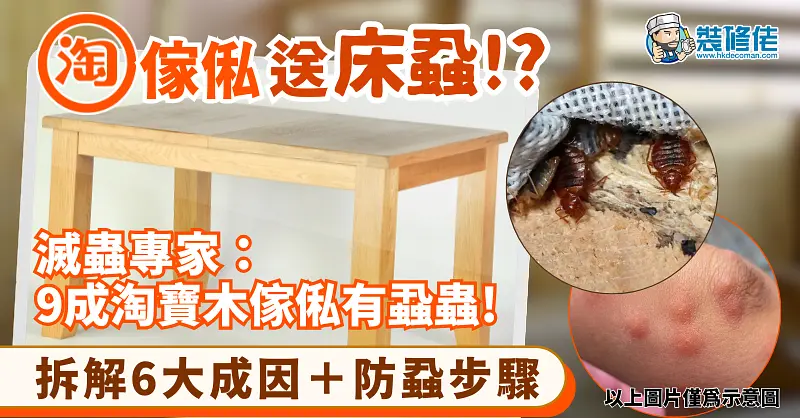Beware Taobao Bedbugs in Furniture
Listen to the blog audio:

Taobao has become a popular choice for many Hong Kong people to purchase furniture, mainly due to its wide variety of styles and affordable prices. However, there is a hidden risk of bedbugs (also known as wood bugs or stink bugs) that should not be overlooked. This can easily turn a cost-effective deal into a costly home problem. In recent years, there have been numerous cases on social media platforms of severe bug infestations caused by online furniture purchases. Let Renovation Man compile a few cases and expert opinions to provide you with a practical guide to preventing bedbugs.
To Save Money Buying Furniture on Taobao, Ended Up "Getting Bed Bugs for Free"
A mother once shared her troubles online. To save on expenses, she bought a dining table from Taobao, and soon after, bed bugs appeared in her home, with her young son covered in red, swollen bite marks from the bed bugs. Even though she quickly disposed of the newly purchased dining table and the affected mattress, the bed bug infestation in her home still couldn't be resolved.
Another Hong Kong father had a similar painful experience. He bought a baby bed for his newborn from Taobao for just over two hundred dollars, which was also found to harbor bed bugs, and they quickly spread throughout the entire house. Other netizens also reported that wooden shelves they purchased came with bed bug eggs, ultimately leading to a full-house infestation. Pest control experts have pointed out that in recent years, a significant portion of the bed bug help cases they handle trace back to furniture bought online. They even stated that, based on their experience, 90% of furniture bought from Taobao comes with bed bugs, and this involves a series of systemic factors.

Illustration (Online Image)
Why Are Taobao Wooden Furniture High Risk? Experts Reveal 6 Key Factors
Why does furniture purchased online from mainland China, especially wooden products, become a transmission medium for pests like bed bugs? Based on pest control experts' analysis, there are six main reasons:
- Lack of High-Temperature Pest Control Treatment: Compared to formally imported furniture, many domestically produced woods in mainland China may not undergo strict high-temperature or chemical pest control treatment during processing. The absence of this step allows insect eggs hidden deep within the wood to survive.
- Materials Prone to Hiding Insect Eggs: To reduce costs, much online furniture uses composite boards like "bagasse board" or plywood. These boards have a relatively loose texture with many tiny gaps, providing ideal conditions for bed bugs to lay eggs and hide.
- Poor Storage Environment Hygiene: In mainland China's vast logistics network, some furniture factories or consolidation warehouses may have damp storage conditions with suboptimal hygiene. Such environments are prone to breeding mosquitoes and bed bugs, and furniture stored there for long periods is easily "infected."
- Packaging Cardboard as a Medium: Even if the furniture itself is fine, the corrugated cardboard used for packaging can be a source of transmission. The layered structure of cardboard is also a favorite hiding spot for bed bugs, and in humid warehouse conditions, it can harbor insect eggs or adults, which are delivered along with the goods.
- Lack of Quality Supervision: Online shopping often involves direct factory shipping, skipping the display and storage stages of physical furniture stores. In traditional retail models, goods are stored in stores for some time, allowing early detection of pest issues. Direct shipping means that if the goods have pests, they are brought directly into the home.
- Climate Factors as Catalysts: Hong Kong's summer weather is hot and humid, which is an active period for bed bug reproduction. When insect eggs or larvae hidden in wooden boards encounter Hong Kong's high-humidity environment, they are activated, quickly hatch, and spread rapidly.

Illustration
Re-understanding Bed Bugs: They're Not Just Itchy
Bed bugs, scientifically known as Cimex lectularius, are parasitic insects that survive by feeding on the blood of warm-blooded animals. They are small, flat, reddish-brown in color, and extremely resilient, able to survive for several months to a year without food. Bed bugs are nocturnal insects, typically hiding in dark places such as mattress seams, bed frames, wall cracks, and furniture crevices during the day, and emerging to feed when people are asleep.
After being bitten by bed bugs, the skin may develop red, swollen, and itchy papules; in severe cases, it can lead to blisters, extensive rashes, and allergic reactions. Persistent itching not only severely affects sleep quality but excessive scratching may also cause secondary skin infections. Additionally, ongoing infestations can cause significant psychological stress, leading to anxiety, fear, and a sense of insecurity about one's living environment.

First Line of Defense: 4 Steps to Prevent Bed Bugs When Receiving and Unpacking Goods
Prevention is key to dealing with bed bug issues. Learning how to safely receive and handle packages is an important step in protecting your home. Pest control experts recommend following these four steps when receiving online purchases (especially large furniture):
- Unpack in the center of the living room: Try to unpack in an open area like the center of the living room. Before unpacking, lay down a plastic sheet or old newspaper on the floor so that if any bugs fall out, they can be spotted and dealt with immediately.
- Check the packaging appearance: Carefully inspect the surface of the cardboard box, especially the corners and seams. If you find dark or brownish-black tiny spots (which could be bed bug excrement) or any tiny live bugs, it indicates a high risk of infestation.
- Perform initial disinfection: Before opening the cardboard box, you can spray the entire surface of the package with diluted alcohol or disinfectant spray, especially in the crevices, to kill some of the adult bugs or larvae attached to the surface.
- Inspect the goods carefully: After opening the package, inspect each component one by one. Pay special attention to the edges of wooden boards, drill holes, joints, and all tiny gaps to check for live bugs, white or pale yellow eggs (about 1mm in size), or shed bed bug skins.
- If you find a small number of pests, you can immediately treat them with insecticide; if you find bed bugs, use a handheld steam iron or hairdryer to kill them with high heat. If you find a large number of pests or eggs, the safest approach is to immediately seal the entire item properly and dispose of it, and all packaging cardboard boxes should also be discarded immediately.
A Major Taboo: Do Not Use 'Bug Bombs'
If you unfortunately discover bedbugs at home, it is crucial to stay calm and take the correct handling methods. Wrong methods are not only ineffective but may also worsen the problem.
Important reminder: Avoid using 'fogger bug bombs' Many people use foggers when encountering pest infestations, but this is an incorrect strategy for dealing with bedbugs. The irritating gas from foggers only drives bedbugs from their hiding places to other unaffected areas of the home, such as spreading from the bedroom to the living room, thereby expanding the control area and increasing the difficulty of treatment.

Effective DIY Bed Bug Control Strategies:
1. High-Temperature Treatment Method: This is the most effective and environmentally friendly method. Bed bugs and their eggs will die at temperatures of 60°C or higher.
- Clothing and Bedding: Wash all suspected contaminated clothing, bed sheets, duvet covers, curtains, etc., in hot water not lower than 60°C, then dry at high temperature or expose to direct sunlight.
- Mattresses and Furniture: Use a handheld steam garment steamer or steam iron to perform high-temperature steam treatment on all seams of mattresses, bed frames, sofas, and furniture, ensuring the heat penetrates. This step requires patience and repetition.
2. Physical Removal Method:
- Vacuum Cleaner Treatment: Use the narrow crevice attachment of a vacuum cleaner to perform strong suction on all possible hiding spots for bed bugs, such as bed edges, wall corners, and furniture seams. After completion, immediately seal the vacuum bag in a plastic bag and dispose of it.
- Freezing Treatment: For small items that cannot be washed or heated, place them in a sealed plastic bag and freeze at -18°C for at least 24 hours.
3. Auxiliary Chemical Control:
- Diatomaceous Earth (DE Powder): This is a physical insecticide whose powder can damage the waxy outer layer of bed bugs, causing them to dehydrate and die. For safety, experts recommend mixing DE powder with a small amount of water and then spraying it. After the water evaporates, the powder will adhere to surfaces and continue to work. There are also water-based sprays available on the market, but be careful to avoid using them near electrical outlets.
[Editor's Picks]
From renovation quotes to move-in and beyond, comprehensive one-stop support!
>> Get a free renovation quote: https://hkdecoman.com/measure
>> Book a home clinic appointment (property inspection/cleaning/repair): https://clinic.deco-x.com/
Specialized sections for various property types:
>> Public Housing https://decoman-publichousing.com/
>> Private Housing https://decoman-privatehousing.com/
>> New Properties https://decoman-newproperties.com/
>> Tenement Buildings https://decoman-tenement.com/
================================================================
*** This article is authorized for republication by Renovation Man ***
